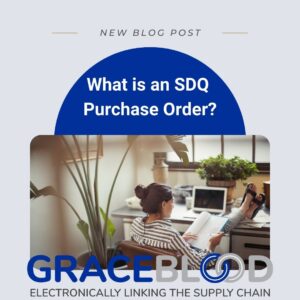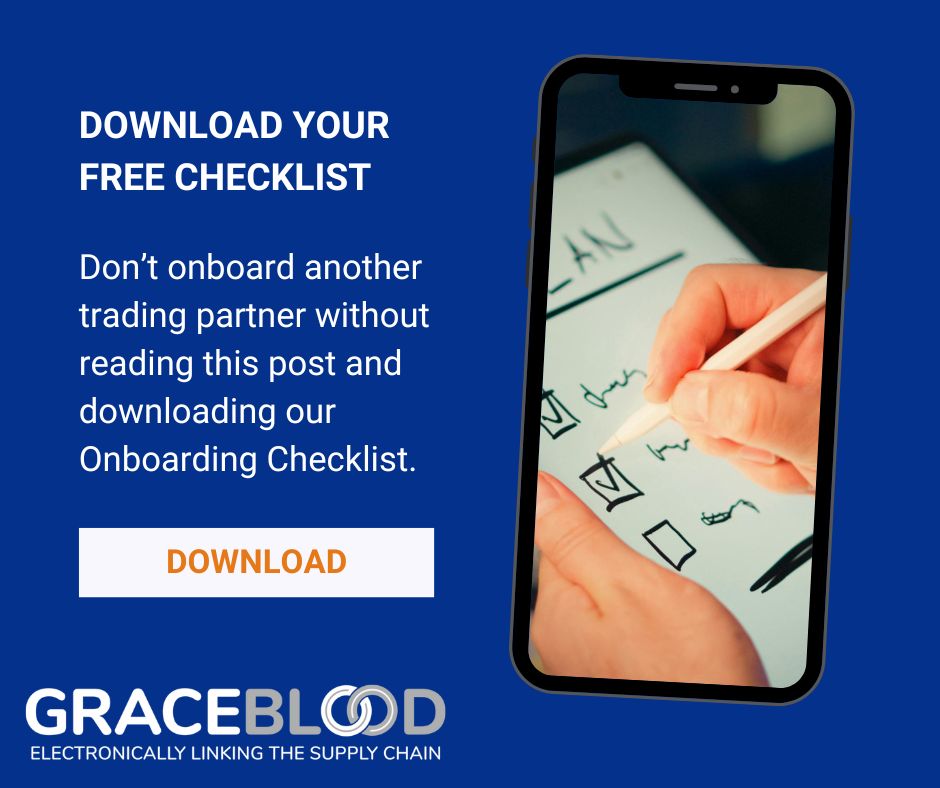
Updated 8/22/25
Electronic Data Interchange (EDI) has been around for decades, streamlining the way companies exchange business documents like purchase orders, invoices, shipping notices, and other critical files. For many organizations, implementing an EDI system has already eliminated mountains of paper, reduced manual processes, and deepened trading partner relationships. But despite its proven ROI, countless businesses still stop short of full EDI enablement across their supply chain.
Some companies transact 30%, 50%, or even 80% or more of their business via electronic data exchange—yet they still send hundreds of orders or invoices by email or PDF. That last percentage of suppliers and customers who aren’t EDI-capable continue to drag down efficiency and inflate costs.
This blog explores what EDI enablement really means, the dangers of outdated and forced models, and why now is the time to onboard your entire partner community with a modern, flexible approach.
Wikipedia describes the benefits of supplier enablement being, “…reduced supply chain costs, improved invoice tracking, reduced procurement costs, reducing or eliminating non-value added (manual) processes, and improved communications.” Many hubs do not fully invest in a supplier enablement program for fear of alienating their suppliers, which is a valid concern. But I say, “Go big or go home.” You’re not fully realizing the benefits of EDI or data integration when 50% of your suppliers and/or customers are still doing business with you over email! The key to selling EDI onboarding to your partner community is making them understand the benefits to them, as well as offering them affordable and user friendly options. Below I have outlined the most basic benefits of EDI implementation for all parties.
Table of Contents
- What is EDI Enablement?
- Why Many Businesses Stop Short of Full Enablement
- The Dangers of Forced EDI Enablement
- Why EDI Enablement and B2B Integration Benefits Everyone
- Debunking Common Myths About EDI Enablement Compliance Requirements
What Is EDI Enablement?
Simply put, EDI enablement is the process of bringing your entire supplier or customer community into your EDI ecosystem. Instead of limiting EDI format to just your largest or most sophisticated partners, EDI enablement aims to eliminate all manual or non-integrated processes across your supply chain.
It’s not just about compliance or using an EDI message format like EDIFACT or ANSI X12. True EDI enablement is about inclusivity—giving every supplier and customer, regardless of size or technical maturity, a way to connect electronically. Done right, enablement leads to:
- Reduced supply chain and procurement costs
- Improved data accuracy and invoice tracking
- Stronger, more collaborative supplier relationships
- Enhanced visibility and analytics for strategic decision-making
- Faster order-to-cash and procure-to-pay cycles
In other words, EDI enablement is the difference between dabbling in EDI and actually reaping its full value.
Why Many Businesses Stop Short of Full Enablement
If EDI is so beneficial, why don’t more organizations fully enable their trading partners? The reasons are familiar:
- Supplier pushback. Smaller vendors fear the cost or complexity of EDI integration projects.
- Internal onboarding costs. Each new trading partner requires testing, EDI mapping, and coordination.
- Limited resources. IT teams often prioritize other projects over the EDI integration process.
- Complacency. “80% of our business is EDI already—that’s good enough.”
But here’s the catch: that remaining 20% of manual transactions is often the most expensive. When you account for data entry errors, corrections, and delayed payments, those costs stack up fast. The average cost of processing a paper-based transaction can be $4–$5, versus pennies for an automated EDI file exchange. At scale, those differences translate into massive operational inefficiencies.
The Dangers of Forced EDI Enablement
Historically, some large retailers and manufacturers have handled EDI enablement through third-party EDI service providers. The model often looks like this:
- The hub company outsources supplier onboarding to a designated EDI provider.
- Suppliers are told they must work with that provider or pay hefty testing and compliance fees.
- The provider profits no matter what—suppliers either adopt their solution or pay penalties.
On the surface, this is efficient for the hub: no internal testing, no supplier training. But it comes at a cost: resentment and churn. Suppliers often feel coerced, saddled with unnecessary expenses, and locked into an EDI platform that doesn’t fit their business.
This “forced enablement” model may achieve compliance, but it undermines trust and long-term collaboration. In some cases, small suppliers even drop major customers rather than endure unfair enablement practices. That’s a lose-lose scenario.
A Smarter, Modern Approach to EDI Solution Enablement
Thankfully, the industry is shifting toward a more respectful, flexible model of supplier onboarding. Instead of a one-size-fits-all mandate, modern EDI enablement recognizes that every supplier is unique.
Best practices for supplier enablement include:
- Recognize each supplier as an independent business. Don’t assume every vendor can adopt direct EDI in the same way.
- Offer multiple options. Some suppliers may use full EDI integration solutions, others might prefer a secure web portal, and some may start with hybrid options like API integration alongside EDI.
- Communicate clearly, internally and externally. Keep suppliers informed, but also align internal teams (procurement, IT, finance, and ERP system managers) on the enablement strategy.
- Adopt a phased rollout. Start with priority partners, then expand. Avoid overwhelming your suppliers—or your own team.
- Treat enablement as an ongoing journey. Onboarding isn’t a one-time project; it’s a program that requires consistent support and evolution.
This inclusive, supplier-friendly service approach leads to stronger adoption and better relationships—without alienating partners.
Why EDI Enablement and B2B Integration Benefits Everyone
Benefits to the Hub (Your Organization)
Better Data & Analytics
Manual processes introduce errors. Bad EDI data or incomplete imports disrupt decision-making and are costly to fix. EDI ensures clean, trusted, real-time information, empowering leaders to make informed decisions across the enterprise.
Lower Costs per Transaction
While manual processing costs average $4–$5 per document, automated EDI workflows cost only pennies. Multiply that across thousands of invoices, purchase orders, and shipping notices, and the savings become enormous.
Fewer Errors
Manual data entry has a 3–5% error rate, and fixing errors later in end systems can be exponentially more expensive. EDI translation automates this step, reducing costly mistakes.
Visibility & Control
EDI delivers real-time insights into supplier performance, order statuses, and potential disruptions. With strong data integration across ERP integration and other systems, companies can avoid shortages, delays, or excess inventory.
Benefits to the Supplier
Faster Payments
EDI shortens the order-to-cash and procure-to-pay cycle from weeks to days. Improved cash flow is vital for small and mid-sized suppliers.
Competitiveness
Suppliers who work with the right EDI solution gain automation capabilities that make them more attractive to new customers.
Better Customer Relationships
EDI simplifies business communication, making suppliers easier to work with. For many, it strengthens the role of the EDI buyer within large enterprises.
Cost Savings
Less paper, fewer errors, and faster cycles mean tangible cost reductions. Suppliers benefit as much as their customers.
Debunking Common Myths About EDI Enablement & Compliance Requirements
Even today, misconceptions hold companies back from full enablement. Let’s set the record straight:
- “It costs suppliers too much.”
Fifteen years ago, yes. Today, modern EDI integration platforms make entry affordable—even cheaper than processing a handful of manual transactions. - “Suppliers refuse to participate in an EDI program.”
Resistance is natural. But when suppliers are given options—like phased EDI workflows or hybrid digital exchange methods—adoption rates rise dramatically. - “EDI costs us too much to add new partners.”
With cloud-based EDI expertise and flexible pricing, onboarding is faster and more affordable than ever. - “We don’t have resources to train suppliers.”
Many EDI partners now offer outreach, education, and technical implementation support. They’ll walk suppliers through the EDI integration process step by step. - “We already do 80% of our business via EDI.”
That last 20% is often the most expensive. Competitors who eliminate manual processes and replace with EDI transaction and automated workflows gain a margin advantage.
Go Big or Go Home: Why Now Is the Time for Full EDI Integration and Enablement
The business case for full enablement has never been stronger. Supply chain disruptions, rising costs, and competitive pressures demand agility. Clean, automated flows of EDI information across an enterprise resource planning environment aren’t just “nice to have”—they’re essential.
If your company has already invested in EDI technology, why stop halfway? Every manual transaction left in your process is a missed opportunity for savings, accuracy, and stronger supplier relationships.
Modern EDI enablement isn’t about forcing suppliers and customers into rigid systems. It’s about creating an ecosystem where every partner—large or small—can connect in a way that works for them. Whether through EDI integration platforms, API integration, or phased EDI adoption, the result is a supply chain that’s faster, smarter, and more resilient.
Next Steps: Getting Started with EDI Enablement
If your organization is still relying on partial EDI adoption, it’s time to rethink your strategy. Ask yourself:
- How many of my suppliers and customer still send business data via PDFs or email instead of EDI workflows?
- What is that costing us in manual processing, errors, and delays?
- What would it mean if all our partners were sending and receiving EDI documents, even the smallest ones?
The answers may surprise you—and they’ll almost certainly highlight opportunities for significant cost savings and competitive advantage.
Ready to get started? Speak with an EDI partner who can design an EDI enablement program tailored to your business and supplier community—whether you need EDI integration solutions, ERP integration, or hybrid digital exchange approaches.








